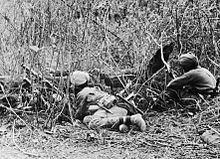
Burma campaign
1941–1945 campaign during World War II / From Wikipedia, the free encyclopedia
Dear Wikiwand AI, let's keep it short by simply answering these key questions:
Can you list the top facts and stats about Burma campaign?
Summarize this article for a 10 years old
The Burma campaign was a series of battles fought in the British colony of Burma. It was part of the South-East Asian theatre of World War II and primarily involved forces of the Allies (mainly from the British Empire and the Republic of China, with support from the United States) against the invading forces of the Empire of Japan. Imperial Japan was supported by the Thai Phayap Army, as well as two collaborationist independence movements and armies. Nominally independent puppet states were established in the conquered areas and some territories were annexed by Thailand. In 1942 and 1943, the international Allied force in British India launched several failed offensives to retake lost territories. Fighting intensified in 1944, and British Empire forces peaked at around 1 million land and air forces. These forces were drawn primarily from British India, with British Army forces (equivalent to eight regular infantry divisions and six tank regiments),[31] 100,000 East and West African colonial troops, and smaller numbers of land and air forces from several other Dominions and Colonies.[6] These additional forces allowed the Allied recapture of Burma in 1945.
| Burma campaign | |||||||||
|---|---|---|---|---|---|---|---|---|---|
| Part of the Pacific War during World War II | |||||||||
 Sikh soldiers of the 7th Indian Infantry Division at an observation post in the Ngakyedauk Pass, February 1944 | |||||||||
| |||||||||
| Belligerents | |||||||||
Medical support: |
| ||||||||
| Commanders and leaders | |||||||||
| Strength | |||||||||
|
1942–1943 1944–1945 |
1942–1943 1944–1945 | ||||||||
| Casualties and losses | |||||||||
|
|
| ||||||||
| 250,000[30] to 1,000,000[20] Burmese civilians killed[lower-roman 8] | |||||||||
| |||||||||
|
Military campaigns of the Empire of Japan | |
|---|---|
The campaign had a number of notable features. The geographical characteristics of the region meant that weather, disease and terrain had a major effect on operations. The lack of transport infrastructure placed an emphasis on military engineering and air transport to move and supply troops, and evacuate wounded. The campaign was also politically complex, with the British, the United States and the Chinese all having different strategic priorities. It was also the only land campaign by the Western Allies in the Pacific Theatre which proceeded continuously from the start of hostilities to the end of the war. This was due to its geographical location. By extending from South East Asia to India, its area included some lands which the British lost at the outset of the war, but also included areas of India wherein the Japanese advance was eventually stopped. The climate of the region is dominated by the seasonal monsoon rains, which allowed effective campaigning for only just over half of each year. This, together with other factors such as famine and disorder in British India and the priority given by the Allies to the defeat of Nazi Germany, prolonged the campaign and divided it into four phases: the Japanese invasion, which led to the expulsion of British, Indian and Chinese forces in 1942; failed attempts by the Allies to mount offensives into Burma, from late 1942 to early 1944; the 1944 Japanese invasion of India, which ultimately failed following the battles of Imphal and Kohima; and finally the successful Allied offensive which liberated Burma from late 1944 to mid-1945.
The campaign was also strongly affected from the political atmosphere which erupted in the South-East Asian regions occupied by Japan, who pursued the Pan-Asianist policy of a "Greater East Asia Co-Prosperity Sphere". These led to a Japanese-sponsored revolution during the initial invasion and the establishment of the State of Burma, whose Burma Independence Army had spearheaded the initial attacks against the country. The Provisional Government of Free India, with its Indian National Army led by Subhas C. Bose of the Free India movement, fought under or alongside Imperial Japan, especially during Operation U-Go in 1944. The INA had earlier collaborated with Nazi Germany. The dominating attitude of the Japanese militarist who commanded the army stationed in the country, ultimately doomed the co-prosperity sphere as a whole, leading to local hopes for real independence fading and a revolt by the Burma National Army in 1945. On the Allied side, political relations were mixed for much of the war. The China Burma India Theater American-trained Chinese X Force led to cooperation between the two countries, but the clashing strategies proposed by General Joseph Stilwell and Chinese Generalissimo Chiang Kai-shek would lead to Stilwell's eventual removal from his position as American Commander of the theater. On the other hand, China–India relations were positive from the cooperative Burma Road, built to reach the Chinese Y Force and the Chinese war effort inside of China, as well as from the heroic missions over the extremely dangerous air route over the Himalayas, nicknamed "The Hump". The campaign would have a great impact on the independence struggle of Burma and India in the post-war years.